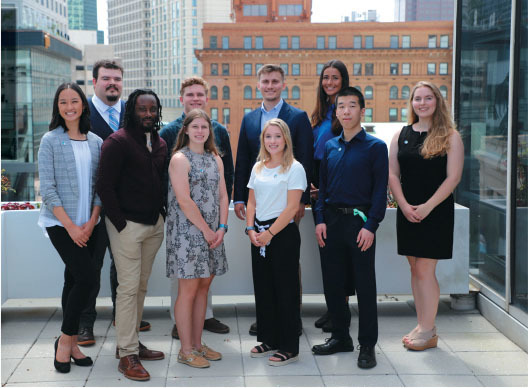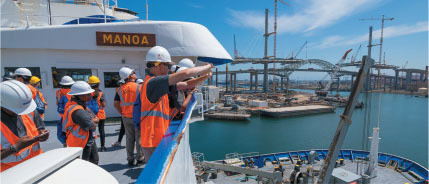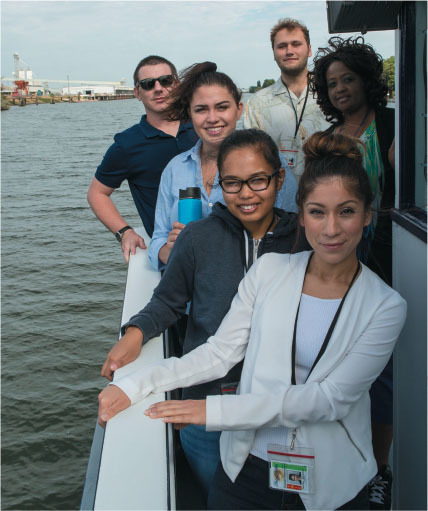
As businesses of all types struggle to hire, retain and train talented employees, many ports are turning to internship and apprenticeship programs to showcase the wide variety of career opportunities available at ports. Although ports are economic drivers in their communities, many students aren’t aware of what ports do and how they might fit into their operations. That’s why it pays for ports to reach out to them and raise their awareness, said Alex Liverman, manager of talent acquisition at the Virginia Port Authority.
Which is exactly what The Port of Virginia has been doing.
The Port of Virginia hosts more than a dozen interns each summer for an eightweek program, offering opportunities in human resources, operations and maintenance, administrative services and compliance, innovation, sales, public affairs, marketing, financial services and legal.
To promote the internship program, port executives have attended college job fairs, posted ads on Instagram, LinkedIn and Facebook, and promoted it through their industry contacts. In turn, interest has swelled, with 615 applications received from students at 139 colleges and universities this year, according to Liverman.
Whatever you’re studying in college, there’s likely an internship worth pursuing at The Port of Virginia, where you’ll get paid an hourly wage, pad your résumé, make professional contacts, apply what you’ve learned in the classroom and acquire new skills. Just as important, however, you’ll essentially be auditioning for a full-time job at the nation’s fifth-largest port, which is good work if you can get it. Since the 2015 launch of the program, 14 interns, about one-quarter of the total, have accepted full-time jobs at the port, providing a pipeline of young, ambitious workers.

“Providing opportunities to students has allowed our organization to diversify and grow our talent pool and partnering institutional programs,” Liverman said. “It is both rewarding and impressive to see the level of passion and hard work our interns have given over the years.”
When their schools allow it, interns can earn college credits for completing the summer program. Either way, they’ll surely enhance their career readiness. At the end of the eight weeks, interns give a short presentation about the project they worked on in front of port employees, allowing them to gain public speaking experience and develop poise.
Mathew Kaiser, a student at Longwood University who interned in gate and yard operations at the port last summer, said the program appealed to him because it meant “being a part of something that’s so crucial to Virginia’s industry.” In May, he joined the port full time as assistant operations manager.

“I would say the culture is welcoming,” Kaiser said. “From Day 1, I felt like I was a member of the team. I was treated as an equal.”
Lily Tomlinson, a student at Anderson University, said her internship last year sparked her curiosity about the industry.
“As a marketing intern, I never expected to not only learn as much as I have about the port’s operations but also to love it as much as I do,” she said. “I have asked so many questions about how the port works … because it’s so interesting and it’s something that I’ve grown to love learning about.”
Here’s a look at how four other North American ports are using internships and apprenticeships to build the workforce of the future.

Offer Internship Programs All Year Round, Not Just in the Summer
You don’t have to wait for summertime to get an internship at Port Saint John, located on Canada’s Atlantic Coast. The University of New Brunswick’s cooperative education program requires students to spend a semester interning at prominent local businesses in order to graduate, and nearby schools such as Eastern College and New Brunswick Community College have similar programs.
Last fall, the port hosted three interns pursuing master’s degrees in business administration from the University of New Brunswick, according to Emily McGill, human resources manager at Port Saint John. One intern worked in the engineering department, another in public relations and community engagement and another in the cruise department. Saint John is the only major city on the Bay of Fundy, known for having the highest tidal range in the world, making it a popular port for cruise ships.
McGill said she works with different department heads throughout the year to identify upcoming projects or skills gaps among the port’s current workforce. Those instances represent opportunities for paid internships, and if they perform well, those students might be invited to stick around.
Among the port’s interns last fall was Chisom Ezeh, who excelled in her job duties and subsequently landed a full-time position conducting community outreach for the port. Having developed customer-service skills while working for a bank in her native Nigeria, Ezeh was a “natural fit for this position,” McGill said.
This year, the port hired Joanna Daramola, a local high-school student, as an intern with the engagement and sustain-ability team.
“This is a great way for us to find future employees,” McGill said. “It’s a chance to get someone through the door and show them the things that we do at the port. We’re a busy port, so there’s lots of work to do. Students get exposure to the world of work while really, truly contributing to our success.”
As one of the area’s major employers, Port Saint John gets plenty of interest from students, especially since many need internships to graduate. Those who make the cut gain opportunities to build their professional network through the port’s partnerships with local businesses and provincial and federal government agencies, McGill said.
“It’s a chance for students to be exposed to a whole network of people who may be able to help them in the future,” she said.
Start Your Internships at the High School Level
You don’t necessarily need a college degree to play an important role in port operations, which is one of the reasons the Port of Long Beach’s internship program starts at the high-school level, according to Kerry Gerot, director of communications and community relations.
The California port typically receives about 300 applications each year for its six-week summer internship program and selects about 25 local students. They work up to 30 hours a week and will make California’s minimum wage of $15 an hour this summer. Not bad for a teenager.

Each week, the port devotes one day to professional and personal development, teaching interns about workplace ethics, financial literacy and the various career paths available to them, Gerot said. The rest of the time, interns work alongside mentors in the port’s various departments, gaining hands-on experience and broadening their skill sets while helping the port address specific needs.
“The earlier you can interest a young person in an industry and show them the opportunities it offers, the more likely it is they’ll consider that industry for their career,” Gerot said. “It opens doors that they might not otherwise be aware of. We’ve found that because we get so many applications, the candidates are really excellent.”

The Port of Long Beach also hires college students and graduate students for internships on an as-needed basis, Gerot said. These interns typically work 20 to 29 hours per week for three months to a year, but internships may last as long as two years.
Gerot said the port has hired high-school and college interns to full-time jobs. Several came aboard right after graduation, but others, fondly remembering their internships, gained experience elsewhere and then came back to the port when they wanted to make a change.
“There’s absolutely mutual benefit to these internships,” Gerot said. “Not only do they provide training and paid positions to the candidates, but for the port, we actually are seeding the workforce of the future. We are educating students on opportunities here that they may not have thought about before. We know there are a lot of port positions that need filling, so this is part of our workforce development initiative.”
Broaden the Scope of the Internship
With only about 115 employees and very little turnover, the Port of Stockton doesn’t view internships as a response to the national labor shortage, according to Katie Miller, deputy port director for administration. Instead, the goal is to provide “real-world work experience for qualified college students and the opportunity to gain marketable skills and insight into potential career choices,” she said.
The California port hosted a handful of interns each year prior to COVID-19 and is looking forward to restarting the program next year, Miller said. Heads of departments such as human resources, information technology, maritime operations, accounting and the police department may request an intern to work on specific projects. Miller said the focus is on giving interns a “meaningful experience, not just shredding or filing.”

The Port of Stockton reaches out to local colleges, some of which require students to have an internship before graduating, to promote its program. And it expects port executives to devote considerable time to working with interns, ensuring that they gain valuable experience. But even those students who aren’t selected can benefit from the application process, Miller said.
Interested students have to fill out a job application, something they may not have done before, and leading candidates are interviewed by port executives, an experience that serves them well as they enter the job market, she said. Some students who weren’t selected have requested feedback on how they could have handled the process better, and the port typically will provide constructive criticism, something it may not do for more established job applicants, Miller said.
Interns work on their projects for up to four days a week, with the other day spent on career readiness and professional development. During those sessions, executives typically give a PowerPoint presentation detailing what their department does and how it fits into the port’s operations.
The HR department’s presentation focuses on skills such as writing a résumé, etiquette for business lunches and functions, dressing for success, interview tips and workplace communication skills. Conversely, the police department’s presentation may feature a K-9 officer and its handler showing how they work together.
“We try to make it fun, and we have this meeting in different venues around the port so they can see more of our 2,000-acre campus,” Miller said. “Sometimes students don’t know about business etiquette, and we want them to be able to feel confident when they enter the workforce.”
Develop Incentive Programs to Encourage Participation
Developing a skilled workforce was identified as a top priority in the Port of Vancouver USA’s most recent strategic plan, so the Vancouver, Wash., port is bringing more interns and apprentices aboard, “starting small and then scaling up according to the port’s needs,” said Mike Bomar, director of economic development.
In May 2021, the port launched an incentive program helping contractors offset the cost of employing apprentices on public works construction projects costing $500,000 or more. For each project, a goal is established for the percentage of total labor hours to be performed by apprentices. Those companies must submit a “monthly apprenticeship utilization report,” and once they hit their goal, they get $25 for each hour worked by apprentices for the duration of the project.

For its own maintenance department, the port hired three labor apprentices last summer and fall. Over the years, interns have helped to complete a number of important maintenance projects at the port, including paving, gutter repair and installation, landscaping and roof repairs.
Similarly, the Port of Vancouver last year partnered with the U.S. Merchant Marine Academy to sponsor an intern at the port, exposing that student to all commercial and operational aspects of the port. Two interns, one from Texas A&M and another from the California Maritime Academy, will get that opportunity this year, Bomar said.
Another intern will join the port this summer through the Future Leaders Project, a partnership that involves local agencies and educational institutions such as Washington State University’s Vancouver campus. The program pairs students from traditionally underserved communities with local businesses to help them develop the skills to enter the workforce. Selected students work about 20 hours a week from June through August, get a $3,000 stipend and receive ongoing mentorship.

A similar program run by the nonprofit Partners in Careers has helped the port host four high-school students as interns since 2018. Bomar said the port views these opportunities as a way to serve the community by helping young people succeed, and a way to promote the port’s employment opportunities.
“It’s just a sound business strategy,” he said. “Our port, like many, is relatively hidden from people’s day-to-day lives, especially students. Working with our education partners not only benefits our future workforce pipeline but provides exposure to the huge economic impact the port has on our community.”
 AAPA Seaports
AAPA Seaports


